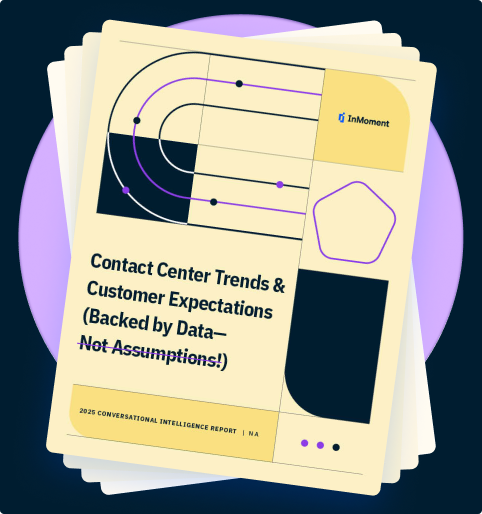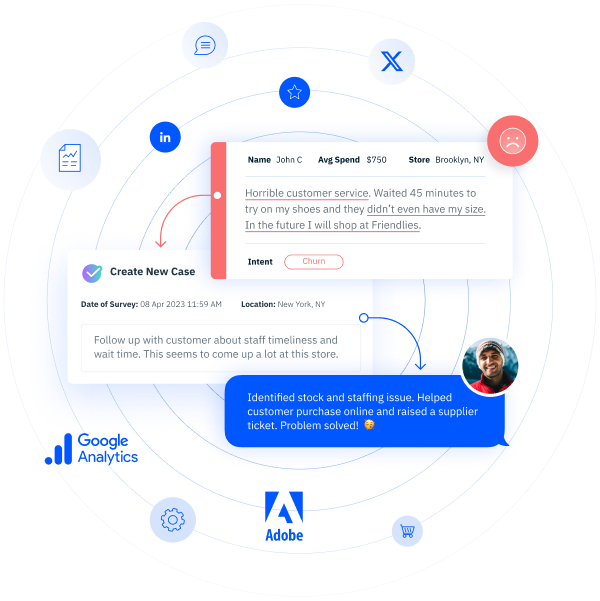How Conversational Intelligence Helps Your Business Win More Sales
Discover how conversational intelligence boosts sales by providing actionable insights, enhancing customer interactions, and driving revenue growth.
In today’s consumer-led economy, your ability to improve the customer experience directly impacts whether you close the deal or lose it. If sales teams can’t resolve issues or respond to concerns fast enough, buyers won’t stick around.
That’s why conversational intelligence (CI) is such a powerful tool for sales-focused organizations. It gives you a clear view into your customers’ minds, surfacing what they care about, their pain points, and what ultimately drives their decisions.
With this level of insight, sales teams and contact centers can fine-tune their approach, strengthen messaging, and close more deals with less guesswork. Think of it as a backstage pass into customers’ motivations delivered in real time.
Below, we break down the top benefits of conversational intelligence and share best practices to maximize its value.
What Is Conversational Intelligence?
Conversational intelligence involves collecting and analyzing sales conversations to uncover actionable insights, improve experiences, and build stronger customer relationships. And while it may sound like a heavy lift, especially with the volume of calls sales teams handle daily, it’s actually the opposite.
Using innovations like artificial intelligence (AI), natural language processing (NLP), and machine learning, conversational intelligence tools break down customer conversations at scale to deliver meaningful findings. This might mean identifying gaps in messaging, highlighting missed opportunities, or revealing exactly where prospects disengage.
With these insights in hand, your team can focus on high-value tasks, like refining pitches, building relationships, and closing deals.
How Can Conversational Intelligence Benefit Sales Teams?
If you’re like many companies right now, you’re keeping a close eye on spending. It makes sense: Budgets are tighter, and every investment needs to earn its place. However, conversational intelligence may be the missing link between your team and stronger sales performance.
From speeding up issue resolution to delivering sharper customer insights, conversational intelligence helps teams move faster, sell smarter, and adapt in real time. It’s more than just a CX tool—it’s a competitive edge for businesses that want to rise above the noise and stay there.
Here’s how it helps sales teams thrive at every stage of the sales cycle:
Speed Up Customer Issue Resolution
Sales reps deal with a steady stream of questions, concerns, and objections before closing deals. Keeping track of them all isn’t easy, unless they’ve got the memory of an elephant.
That’s where conversational intelligence earns its keep. It monitors sales conversations in real time, identifies common problem areas, and flags patterns before they derail. With these insights, reps can resolve issues faster and keep momentum going. Sometimes, that’s the difference between a sales cycle that takes weeks and one that drags on for months.
Boost Agent Performance and Job Satisfaction
Trying to close a deal without understanding your customers is like taking a shot in the dark. You might get lucky, but more often than not, you’ll miss the mark.
Conversational intelligence reduces that risk. It analyzes customer interactions to highlight what drives conversions and where prospects tend to drop off in the sales cycle. These conversation insights can be used to train sales teams and support agents more effectively, boosting their confidence, sharpening their skills, and improving overall performance.
The ripple effect? Greater job satisfaction and higher retention. And considering that the cost of replacing a team member can be three to four times their salary, that’s a win worth investing in.
Lower Service Costs and Streamline Response Times
Depending on your industry, sales costs can eat up 15–30% of total revenue. But they don’t have to.
When you invest in solutions that help you shorten the sales cycle, like conversational intelligence, you cut the guesswork and reduce the cost per sale. Instead of chasing dead ends or repeating the same ineffective tactics, reps can focus on what actually moves deals forward. Fewer wasted sales calls. Fewer missed opportunities. Lower service costs.
CI also helps your team move faster by pinpointing common customer questions and proven resolutions. The result is faster, more consistent reply times that keep customers engaged and momentum high.
Increase Customer Lifetime Value
Top-performing sales teams don’t just aim for one-time conversions—they build relationships that last.
Conversational intelligence helps by providing valuable insights into what inspires trust, loyalty, and long-term engagement. It can spotlight standout messaging, high-performing reps, and service tactics that turn first-time buyers into brand advocates. With these insights, you can strengthen connections and unlock meaningful revenue growth over time.
Think of it as a playbook for improving customer retention, repeat business, and referrals without having to guess what works.
Prove the Value of Customer Service Efforts
It’s not always easy to link customer service to business results, but conversational intelligence makes it possible.
By turning customer interactions into measurable data, CI allows you to track critical metrics like resolution speed, customer satisfaction score (CSAT), and follow-up success. These insights help connect your team’s efforts to real-world outcomes, like increased sales, reduced churn, and higher retention.
And in today’s “Era of Less,” when decision-makers are tightening budgets, that kind of return on investment (ROI) clarity can make all the difference.
Best Practices for Implementing Conversational Intelligence in Sales Strategies
The best tools only deliver value when they’re implemented intentionally. Here are a few best practices to help you get the most out of your conversational intelligence platform and ensure it’s fully integrated into your sales strategies:
1. Choose the Right Platform
The wrong tool won’t just underdeliver: It might drain resources that are better used elsewhere. That’s why choosing the right conversational intelligence tool is critical.
Start by clarifying your team’s goals. Looking to strengthen sales coaching? Choose a platform that goes beyond summarizing call recordings and includes agent scorecards and coaching workflows. Need real-time insights to improve sales processes on the fly? Prioritize tools with live conversation analysis.
Equally important: integration. Your platform should connect seamlessly with your existing tools, like customer relationship management (CRM) software, to support consistent workflows. It also needs to be intuitive and scalable—something your team can grow with, not just test and abandon after a quarter.
2. Train Your Sales Team
Conversational intelligence is powerful, but only when your team knows how to use it.
Training shouldn’t stop at platform features. Reps need to understand why the tool matters, what kind of insights it delivers, and how to turn those insights into action. For example, if you’re introducing a new insight or behavior to focus on, explain how it connects to outcomes your team cares about, like stronger conversions or a shorter sales cycle.
Take a hands-on approach during sales coaching. Give agents opportunities to explore the new platform, review real call recordings, and practice applying conversational data to actual conversations. The more real it feels, the more likely it’ll stick.
3. Focus on Key Metrics
Conversational intelligence tools can deliver a lot of data. Without focus, it’s easy to get lost in details that don’t drive outcomes.
Start by identifying the metrics that matter most to your team. These might include talk-to-listen ratios, objection-handling success, competitor mentions, or deal progressions. Once you know what to watch, use those insights to shape sales strategies and boost rep performance.
For example, if a data trend shows that reps are dominating the conversation, it may be time to coach more active listening. The goal is to connect the data back to what actually moves deals forward.
4. Integrate into the Sales Workflow
Conversational intelligence shouldn’t feel like extra work. If it does, adoption will drop fast.
Make it part of the natural flow by integrating it with your CRM (for easier follow-ups) and collaboration tools (to streamline insight sharing). Automate message and call uploads wherever possible so reps can stay focused on conversations, not admin work.
The most effective teams embed CI into every stage, from prospecting to post-sale check-ins. When it’s baked into every step, it consistently delivers value and supports customer progression through the sales cycle.
5. Celebrate Wins and Socialize Insights
It’s human nature to fixate on what’s not working. But highlighting what is working builds momentum and motivation.
Celebrate standout moments by recognizing team members who consistently handle calls well. Something as simple as a “Rep of the Week” spotlight for top performers can boost morale, strengthen team culture, and encourage others to level up.
Just as important: socialize your CI insights. Share winning conversations from high-performing reps during team meetings or through collaboration tools, so the whole team can learn from what’s working in real time.
6. Listen to the Voice of the Market
Your customers are already telling you what they need—you just have to listen.
Conversational intelligence tools help you do exactly that by analyzing customer interactions at scale. They reveal emerging needs, market trends, and concerns that are essential to staying competitive. It can also capture customer expectations, making it easier for your team to align messaging with what you can actually deliver and guide future development decisions.
To get even more value, set up keyword alerts for things like feature mentions or pricing concerns. Then review the results with your broader team (sales, management, product development, and marketing teams) to turn raw insights into actionable strategies.
Key Features of Conversational Intelligence for Sales
The right conversational intelligence analytics software can transform how your sales team sells, but only if it has the features to back it up. If you’re evaluating tools, prioritize ones that are purpose-built for performance, insight, and scale:
- AI text and call summaries: Automatically condense long conversations into short, digestible snippets, making it easier to review and act on insights quickly.
- Conversational analytics: Analyzes the flow, tone, and context of conversations to uncover customer sentiment, buying signals, and opportunities to improve the experience.
- Text analytics: Makes sense of unstructured data and highlights trends, anomalies, and recurring themes in customer feedback.
- Transcription capabilities: Converts recordings to text for easier call analysis and coaching
- Impact prediction: Forecasts how a rep’s actions are likely to influence outcomes, using historical data to support faster, smarter decision-making.
- Agent and coach scorecards: Provides a clear view of team performance, spotlighting strengths and opportunities for improvement.
Transform Your Sales Outcomes With InMoment’s Conversational Intelligence
Conversational intelligence has shifted from nice-to-have to a competitive necessity. It empowers sales teams to improve performance, boost job satisfaction, and better understand and respond to customers’ needs and expectations. With the right insights, you can reduce friction in the sales process, build stronger relationships, and unlock long-term growth.
InMoment’s customer experience platform brings it all together. Our conversational intelligence tools analyze phone calls, chat logs, email threads, and survey responses—turning complex data into clear, actionable insights. Your team gets a complete view of what’s working, what’s not, and where to focus next to drive real results.
See how InMoment’s conversational intelligence software can help your team close more deals and elevate the customer experience—schedule a demo today.














